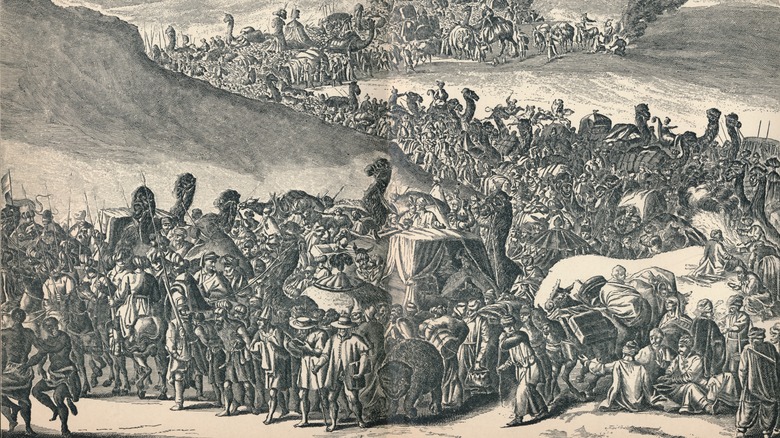The Lavish Life Of The Richest Man Who Ever Lived
Bill Gates. Elon Musk. Jeff Bezos. These are just some of the names that come to mind when considering who might hold the title "the richest man who ever lived." However, the wealth of all three of these billionaires is easily dwarfed when compared to that of Mansa Musa, a 14th century king of the Mali Empire. Per History, Mansa Musa took the throne in 1312 after replacing Abu-Bakr II, who went missing during a voyage by ship in which he intended to find the edge of the Atlantic Ocean. Mansa Musa had served as Abu-Bakr II's deputy. At the time of his rule, the Mali Empire, located in West Africa, was incredibly prosperous thanks to its natural resources of salt and gold.
As most of Europe struggled with civil war and a general lack of resources, the Mali Empire flourished under Mansa Musa's rule and expanded from Africa's western coast to the trade center of Timbuktu and into the Sahara Desert. According to BBC News, the king annexed 24 cities during the course of his rule. His empire eventually stretched over 2,000 miles and included parts of modern-day Senegal, Mauritania, Mali, Burkina Faso, Niger, The Gambia, Guinea-Bissau, Guinea, and Ivory Coast. This meant that the Mali Empire contained nearly half of the world's gold, giving Mansa Musa "almost unlimited access to the most highly valued source of wealth in the medieval world," according to African art specialist Kathleen Bickford Berzock of the Block Museum of Art at Northwestern University.
Mansa Musa announced his wealth via a lavish pilgrimage to Mecca
As reported by BBC News, the Mali Empire wasn't well known despite its enormous wealth until Mansa Musa, who was a devout Muslim, decided to make the pilgrimage to Mecca (depicted above in the circa 1670 illustration). The journey entailed passing through the Sahara Desert and Egypt. Mansa Musa put together an enormous caravan of 60,000 people, including his entire royal court, 12,000 enslaved people, soldiers, entertainers, merchants, and drivers, not to mention 100 camels and large herds of goats and sheep to use for food. The entire party, including the enslaved people, were decked out in gold and silk finery, and each camel carried at least 100 pounds of gold. When the caravan reached Cairo, Egypt, they stayed for three months, and Mansa Musa began distributing gold in such large quantities that the price of gold plummeted and stayed low for a decade, destroying the local economy. The tech company Smart Asset estimated that the economic damage from the pilgrimage led to the modern equivalent of $1.5 billion dollars.
Speaking of modern equivalents, just how much money did Mansa Musa have if it could be translated into today's currency? According to Money, the amount isn't even possible to describe; people struggled to comprehend his riches then and continue to do so now. Per history professor Rudolph Ware of the University of Michigan, "Imagine as much gold as you think a human being could possess and double it, that's what all the accounts are trying to communicate."

